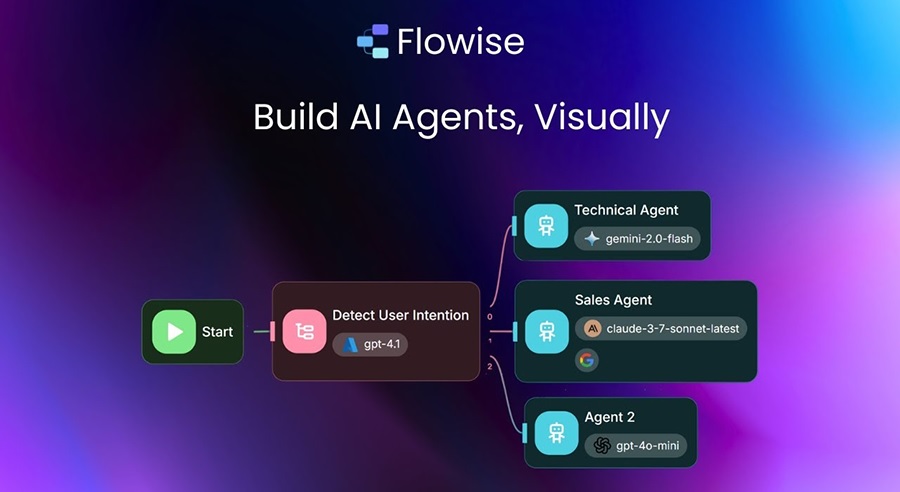
Flowise provides a powerful visual interface for designing AI workflows, but what makes it truly versatile is its ability to connect with external systems. By integrating custom tools, APIs, and SDKs, you can extend your agents far beyond simple Q&A bots. Whether it is pulling in data from your CRM, triggering an action in a third-party service, or embedding custom logic, Flowise can be adapted to fit almost any scenario. This article will guide you through how to connect external components with Flowise, when to use built-in connectors, and how to create custom integrations when your project demands it.
Contents
Why Integrations Matter
An AI agent is only as useful as the actions it can perform. On its own, it can answer questions and generate text. When connected to external tools, it becomes capable of querying data, executing business processes, and collaborating with existing systems. Integrations turn Flowise from a chat engine into a real problem-solver.
👉 Sign up for a free Flowise AI account
Built-in Integrations vs. Custom Tools
Flowise comes with a set of built-in nodes for popular services. These allow you to connect quickly to APIs, vector databases, or messaging platforms. But when you need something unique, you can build your own tools, APIs, or SDK-based connections.
When to use built-in nodes
- For common tasks like PDF loaders, CSV processors, or simple HTTP requests.
- When connecting to popular vector stores like Pinecone or Weaviate.
- If you need rapid prototyping with minimal setup.
When to go custom
- For proprietary systems not covered by built-in nodes.
- When you need advanced logic, such as preprocessing data before passing it back to the agent.
- If your integration requires SDKs or libraries specific to your industry or platform.
Integrating APIs with Flowise
APIs are the backbone of most integrations. With Flowise, you can call external APIs to pull or push data. This can be done through prebuilt API nodes or with custom scripts.
Steps to integrate an API
- Add an API request node to your workflow.
- Configure the endpoint URL, method (GET, POST, etc.), and headers.
- Insert authentication details such as API keys or tokens.
- Connect the API node to your agent’s logic, so it knows when to call the service.
- Test the integration with sample queries to validate results.
Using SDKs and Libraries
Sometimes APIs alone are not enough. SDKs (software development kits) offer richer functionality and prebuilt methods for working with external services. Flowise allows developers to extend workflows with SDKs by embedding custom code modules.
Example: Using a cloud SDK
- Install the SDK (e.g., AWS SDK or Google Cloud SDK) in your environment.
- Create a custom tool node in Flowise that uses the SDK to perform actions.
- Pass results back into the workflow for further processing or output.
Building Custom Tools
If your needs are highly specific, you can build custom tools from scratch. A custom tool in Flowise is essentially a function that your agent can call during its reasoning process.
Best practices for custom tools
- Keep them modular and reusable across workflows.
- Ensure they handle errors gracefully, returning clear messages if something fails.
- Document the tool’s purpose and parameters for future maintainers.
Securing Your Integrations
Security is a critical part of integration. Never embed credentials directly in workflows. Instead, use environment variables or secure credential stores. Limit API permissions to only what your agent needs. Monitor logs for unusual behavior that could indicate misuse or errors.
Testing and Monitoring
Every integration should be tested thoroughly before deployment. Use varied inputs to ensure reliability. Once in production, set up monitoring to track performance and alert you to failures. This ensures your agent remains dependable, even as external services evolve.
Real-World Examples
- Customer service: Agents connected to Zendesk APIs to create and update tickets automatically.
- Finance: Custom tools built with banking SDKs to pull transaction histories securely.
- Healthcare: Agents integrating with EHR (electronic health record) systems through APIs to retrieve patient information.
- Education: Bots calling LMS (learning management system) APIs to fetch course content for students.
Common Challenges
- Latency: External calls can slow response times. Use caching where possible.
- Versioning: APIs and SDKs update over time. Keep your tools up to date to avoid breaking changes.
- Error handling: Always plan for failed requests and timeouts.
- Costs: Some APIs charge per request. Budget accordingly when scaling.
Best Practices for Smooth Integrations
- Start with small integrations and expand gradually.
- Document all external connections and dependencies.
- Use reusable templates for recurring integration patterns.
- Plan fallback behaviors if a service becomes unavailable.
- Keep humans in the loop for high-risk tasks.
Integrating custom tools, APIs, and SDKs with Flowise unlocks the platform’s full potential. It lets you design agents that are not only conversational but also action-oriented, capable of working with your existing systems in meaningful ways. By combining Flowise’s visual design with custom integrations, you can build AI agents that are both powerful and practical, tailored precisely to your organization’s needs.

